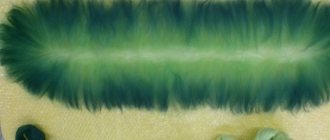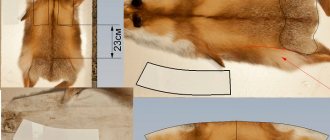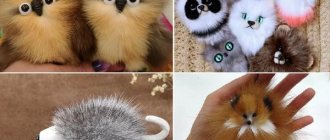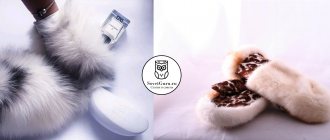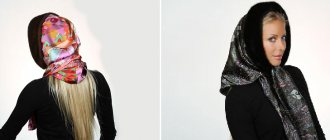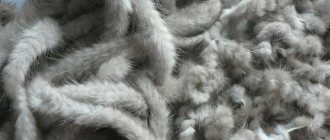Women and accessories are an inseparable concept. The more expensive the decorations, the more luxurious the lady looks. The boa, which appeared back in the Renaissance, is a worthy example of such an accessory. The lady herself decides what to wear with a boa. This accessory has always played a dual role: it warmed the neck in the cool season and created a rich image for its owner. There are more and more types of boas, and some can be created with your own hands.
The name itself comes from the French word “gorge”, which means “throat”. This explains the location of the boa. Since it was not a necessary item of clothing, but served more to decorate a lady and was made from expensive materials, not everyone could afford such a luxury. Silks, furs, velvet... all this was not cheap and was the privilege of wealthy people.
The 19th century was the century of revival of interest in the boa and French fashionistas began to use this accessory quite often. Adult ladies wore rich fur boas, which were made from whole animal skins and were considered a sign of wealth. At the same time, the heads and paws of many were left on, and glass beads were inserted instead of the animal’s eyes. Young girls were required by etiquette rules to wear more modest boas, which were wrapped around the neck and looked like a scarf-collar.
At the beginning of the 20th century, this accessory came to the Russian Empire, which has always been famous for its luxurious furs, and it became very popular among ladies. Boas were mainly used for social events and were paired with a dress. When coats without collars came into fashion, fur boas began to decorate women’s everyday looks. They were made from a variety of animals, such as fox, marten, sable, arctic fox, and mink.
Gradually they went out of fashion and are now more likely to be considered retro accessories. Nevertheless, at the beginning of the 21st century, famous brands such as Prada and Dior remembered them and brought them to the world catwalks. Retro style is relevant and is considered a special chic. Many lovers of antique items go through their grandmother's chest or try to buy something similar at flea markets. It’s not often that you meet a modern woman on the street, on whose shoulders lies a fur coat with paws, a head and glassy eyes. In fashion, different clothes and the appearance of accessories have also changed.
Products that are located in the neck area have always attracted the attention of women and men. Neck scarves, chokers, scarves, stoles, jewelry - some of them have always remained relevant, but others, like the boa, have been undeservedly forgotten. Nowadays, all lovers of vintage products have the opportunity to remember this wardrobe item and use it in their looks.
FUR BOATS
This type of boa has always been the most popular and beloved by ladies, as it looks presentable and expensive. As before, they are made from a wide variety of fur: ermine, broadtail, sable, fox, mink. This accessory is considered a status accessory and is used by many only for special occasions.
Nowadays, natural fur remains an expensive pleasure, so it can easily be replaced with artificial fur, especially since artificial fur is now very beautiful and more diverse.
Boas can have different shapes. They are made in the form of a boa (for example, from swan's down) or a long fur scarf, stola or scarf - snood. There are models that are tied with a ribbon or pinned with beautiful brooches.
KNITTED BOATS
These accessories do not look as chic as fur ones, but they also fit perfectly into women’s looks. Moreover, they are much cheaper and, if desired, you can create them yourself.
The most varied yarns are used, smooth and fleecy. The latter makes boas that look a little like fur. They are fluffy and light. They are made with buttons and fasteners in the form of decorative flowers.
How to make a boa yourself?
If you have unclaimed fur or skin at home, then there is nothing easier than sewing a stylish accessory yourself. A self-made boa can also serve as a wonderful birthday gift for a relative or beloved friend. In addition to fur, you will also need lining fabric and matching threads, needles and scissors.
Cut a rectangular strip from the skin or sew pieces of fur together. Cut the lining fabric to fit the boa, leaving seam allowances. Place the lining and fur right sides together and sew, leaving an open area at one end. Turn the boa inside out and sew the remaining part with a blind stitch. The accessory is ready. If desired, you can add ribbons for tying or a clasp.
FELTED BOATS
Recently, felted wool products have become incredibly popular. Felting masters also paid attention to scarves - boas, which acquired a new meaning in this design. Beautiful colors, unusual shapes and decorations, a combination of felted parts with lace, ribbons and jewelry make them truly unique.
LiveInternetLiveInternet
The definition of a boa from the moment of its appearance changed along with the boa itself, technologies changed, fashion styles changed, and the boa changed along with them.
This is where the confusion in concepts arose. The boas that were worn in the Art Nouveau era and those that are now worn with clothes, for example, in casual style, are equated with vague definitions of the word “fur boa.”
In the history of costume, the boa traces its origins to those neck decorations that were made not from traditional jewelry materials (precious metals and stones), but from velvet, silk or fur and first began to be seen during the Renaissance. The culmination period for boas came at the beginning of the 20th century, and not only for boas, but also fur stoles, capes, boas, muffs, collars, talmas. Fashion historian Alexander Vasiliev in his book “Russian Fashion” notes that sable and ermine fur was especially valued. “Since 1901, silver fox, skunk, whiting and ferret have become fashionable. They are even starting to make two-meter boas from silver fox.”
When making skins for boas, the claws on the paws and even the teeth were preserved, and the eyes were made of colored glass. Stoles made of sable, fox or ermine were also decorated with the tails, paws, and head of the animal. They preferred to wear stoles in pairs with muffs. In the 1920s, the stole was replaced by the extremely popular fox skin, especially the silver fox skin, which was worn draped over the shoulders. The most extravagant ladies could wear two or three fox skins at once.
By the beginning of the twentieth century, there was a myth about a comfortable existence if you find a silver fox of rare beauty. The myth was, not unreasonably, associated with the first successful experiments in breeding and selling the silver-black fox bred from the silver fox. A whole industry of counterfeits arose, which “made” silver foxes... from hares. It is called pointing trade. Her workers were exclusively young women with thin hands, who pulled out white hair from badgers and then sewed them into black hares. A significant fact for the formation of the first fashion for products made from fox skins was that the total amount of fur on the world market exceeded ten thousand skins in 1923. The first fashion was simple - a fox boa, casually thrown over a coat or dress. However, thanks to the beauty of the fur, this style quickly spread among the aristocracy. The beauties of Austria were the most susceptible to this hobby. Owning an etole (a long scarf made of two foxes) was considered especially chic. It should be large enough to wrap around the entire figure. Outstanding specimens reached two and a half meters. Photographers left images of rich beauties of the time with heavily darkened eyes, in dramatic poses, wrapped in a similar scarf, the end of which was sure to drag on the floor. According to some sources, the “Russian style”, which invaded fashion in the mid-20s, also influenced the popularization of fluffy furs (and therefore foxes). The wave of anti-Bolshevik emigration brought with it the spirit of an exuberant “Slavic Byzantium.” Russian fashion houses were opened in Paris, London, and Berlin. The Russian cultural elite also had an indirect impact - under the impression of communicating with his friends Diaghilev and Stravinsky, Gabrielle Chanel creates a fur collection. The highlight of the season is a velvet coat with a straight, almost shirt-like cut, with a voluminous collar, cuffs and a hem made of silver-black fox. The mass recognition of the fox in Europe was also facilitated by the newfangled foxtrot dance (literally “fox step”), brought from America, where it arose at the peak of the pre-crisis craze for the fox.
In 1928, a more affordable variation appeared: a coat without a collar, which was replaced by a removable boa, came into fashion. In theaters, as well as cinemas, where for a long time it was also customary to take off their coats, respectable ladies walked before the start of a show or performance with a boa on their shoulders or on their arm.
In the 1920-50s. boas were considered a very prestigious thing and a sign of wealth. There were times in history when the skin of a silver fox was more expensive than sable (from 8 to 65 sables).
Nowadays, there is confusion between the names “black-brown” and “silver-black” fox . Many people believe that these are synonymous words. And their faith is often reinforced by cinematic images of Russian merchants, dashingly sporting fur coats made from a modern one hundred percent “silvered fox.” In fact, the wild fox found in ancient times was black or brown, which is why it got its name - silver fox. In the dictionary, “brown is a brown, hazel color, iskrasna is blackish,” and a brown fox is one that has a whitish, speckled spine along its dark brown, bluish fur.” According to research from the H Trends publication, science knows of two mutations that determine the color of silver-black and black-brown foxes. The first arose among wild foxes in Canada, the second among foxes of Eurasia and Alaska. Both names use the word “black” because they are caused by mutant genes that cause the appearance of black coloring, and silvering is a factor that is no longer dependent on the presence of black pigment. Previously, the “silver” factor did not play a role: the blacker it was, the more expensive it was. And even a lynx was passed off as a silver fox, repainted black.
The unique, and so valued in our time, silver was noticed only after two decades of breeding work, at which time the brown color also fell into the category of undesirable characteristics. It was from that moment that the farm fox lost its resemblance to the wild silver fox and began to rightfully be called silver-black .
Fur boa definition:
“Boa” according to the Wikipedia dictionary : A boa (gorgette from the French gorge - throat) is a small fur scarf or skin with a head, paws and tail. They were made from the skins of common, silver-black, platinum fox, gray fox, white or blue fox, marten, mink and sable, worn around the neck as an addition to women's outfits, incl. for low-necked dresses, as well as on coats as a collar.
The French themselves called the boa “boa”. Boa (according to GOST) is a women's fur scarf, round in cross-section, 10-15 cm wide, 150-200 cm long. Made from the tails of squirrels, martens, and sables. The boa is worn as a decoration on the shoulders, mainly indoors. Basically, a boa is a narrow, long scarf without lining. According to the Wikipedia dictionary :
Scarf (French echarpe) is a fabric or knitted product in the form of a long strip, worn around the neck, head or shoulders.
“Boa” according to the classification GOST: 10151-75 “Fur Headwear for Women” . Gorgets are made round from uncut skins with the head, paws and tail of the animal, or flat, spread out on a silk lining. Flat gorgets are sewn open and have a somewhat rounded shape . The range of semi-finished fur products is small - fox, arctic fox, marten, sable. Arctic fox skins are sometimes embroidered lengthwise, as a result of which they become longer, but the quality of the hair is not reduced. Women's fur headwear is produced in accordance with GOST 10151-75 “Women's fur headwear. General technical conditions". There are two types of gorgets: round and flat.
Round gorgets are whole, uncut skins of the Arctic fox, silver-black fox, gray and red fox, equipped with an artificial mastic head.
Flat gorgets, less common, unlike round ones, are made from flattened skins , lined. The name “boa” is assigned during certification, in particular, to that product that may not have a head, tail or legs, or be a scarf - a ring, for example. And in the case of a large animal skin, it can be worn not only on the neck, but also on the shoulders and have a lining.
When creating a look, fashion designers are guided not by definitions, but by their own flair and appropriateness, preparing the boa the way they need. And as a result, we often see products that do not fit any definition, or fit all.
If the designer needs to make a reference to Art Nouveau, he can leave the muzzle, paws or tail - these are elements inherent in the era, but not the definition of a “fur boa”, so a product without them can also be a boa.
The variously modified boas can be combined with all styles, incl. “casual - sports style”, smart casual, business casual, street casual, glamour-casual, all-out casual, because fashion is now more eclectic than ever. In such a situation, the product itself, its color, fur, and shape are of great importance. And, most often, this is a scarf-ring made of fur, carelessly wrapping around the neck due to the plasticity achieved using stitching or perforation technologies.
Such a boa could easily be called “neoclassical”. Examples of fur boas in photographs:
Author's article by A. Skornyakova.
Sources:
- "Russian fashion. 150 years in photography." Alexander Vasiliev.
- Illustrated encyclopedia of fashion. L. Kibalova - O. Gerbenova, M. Lamarova.
- History of Costume 1200 - 2000. Joanne Nunn
- Costume from different times and peoples. M.N.Mertsalova
- Edition "Atelier"
- Edition "H-Trends"
- The article uses photos from the fur portal “Furs and Fashion”
- “Commodity research of non-food products” by S.V. Goncharov
- “Designing clothes” L.P. Shershnev
https://www.livemaster.ru/topic/474329-gorzhetka-sut-i-sudba-v-sovremennom-mire
FABRIC BOATS
This type of boa is, in most cases, decorative. Fabric boas are also full of creativity and can be created from different materials and accessories. For all seasons and occasions, craftsmen come up with unusual and intricate models.
